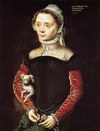2.2 - Artworks of painting and printmaking. Flashcards

By Albrecht Dürer.
Embodies the ideals of the renaissance and the spirit of discovery. Was fascinated with nature. He believed he was endowed with a god-given gift, a humanistic and individualistic view that he shared with Michelangelo and other artists.
His fame derives especially from his prints. In woodcuts and engravings, through the precision and detail of his work as well as the richness and variety of his effects, he was able to achieve monumentality on the scale of a sheet of paper. One of the series of prints he produced is the apocalypse, published in 1498. Consisting of 15 woodcuts with the text printed on the reverse. From the apocalypse series comes the gruesome ´four horsemen of the apocalypse´.
In a woodcut the negative (or white) areas of the final print are cut into the block while the black areas are uncut, and remain raised in relief. Ink is rolled over the surface, paper is placed on the inked surface and the image transferred to the paper by applying pressure to the back of the paper.
By Albert Dürer.
Adam and eve is an engraving, signed and dated on the plaque on the tree branch. He made this in 1504.
He used mathematical proportions and drew from italian works and interpretations of antiquity (his adam resembles the hellenistic greek apollo belvedere, his eve recalls the classical venus de milo). He included the symbols of the four humors, a notion derived from the classical philosophy, in the background of adam and eve. The cat is choleric (angry), the rabbit sanguine (confident), the elk melancholic (depressed) and the ox phlegmatic (impassive).

by Hans Holbein the Younger.
His art reflects the increasing secularity. His fame grew from his portraiture, and painted many important people. Around 1523, he painted Erasmus of Rotterdam, portrait of the famous Dutch humanist.
His working method was to begin with a chalk sketch, the face drawn in careful detail, the body and costume loosely indicated. Later the portrait was painted in his studio. The sitter could also send him any garment he or she wished to be shown wearing. The portraits display exquisite line and sensitive modeling. He always made the sitter look dignified.

By Caterina van Hemessen
One of the most important women painters of the Renaissance in northern europe, specialized in portraiture like many women did. Her portrait of a lady is typical of her work in its small-scale depiction of a single figure standing against a dark monochromatic background. This reversed simplicity accorded with the taste of the time and brought her great succes.

By Pieter Bruegel the Elder.
He portrayed the peasantry and the countryside. Bruegel imitated the paintings of Heronymus Bosch which were extremely popular by the middle of the 16th century. His best paintings depict the daily life or ordinary people (genre painting).
Bruegel was commissioned to paint a series of scenes of the months of the year with one painting representing every 2 months. The harvesters represent august and september. He gave the landscape prominence; nature no longer served merely as a setting for a portrait or religious event. What is new in his paintings, is the way in which the landscape is shown. The figures, rather than being placed in front of a landscape background, are now integrated into the setting. The colors give a feeling of a warm summer afternoon.

By Pieter Bruegel the Elder.
Here Bruegel records the commotion of a rustic wedding.The composition is carefully constructed to appear informal and draw the viewer into the event. The foreground is brought close to the viewer by the figures in the lower left. The arrangement in space is diagonal, the diagonal line of the planks with the desserts continues to recede down to the table all the way to the back of the hall. He uses areas of flat color and simplified forms to create a decorative, patterned quality. His strong, stocky figures convey the robustness and earthy liveliness of this celebration.


